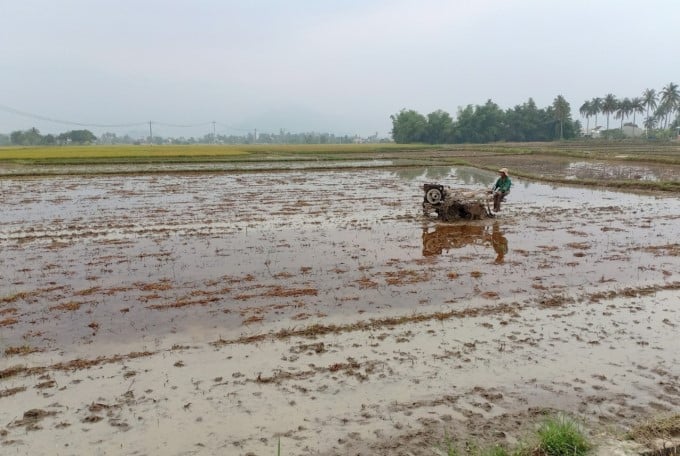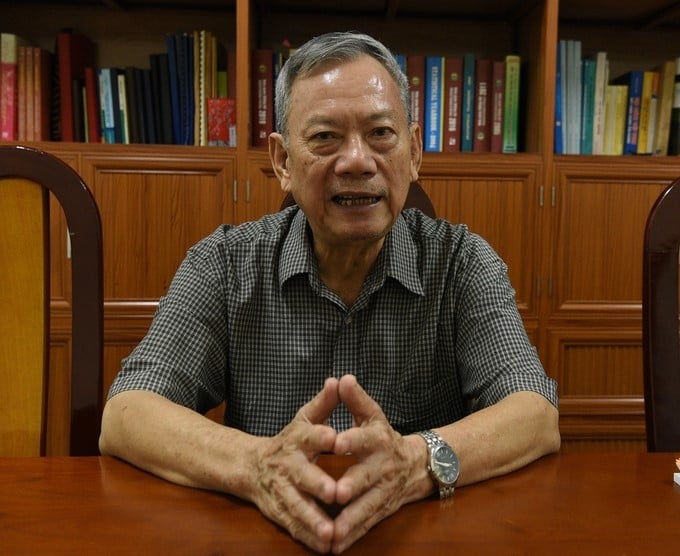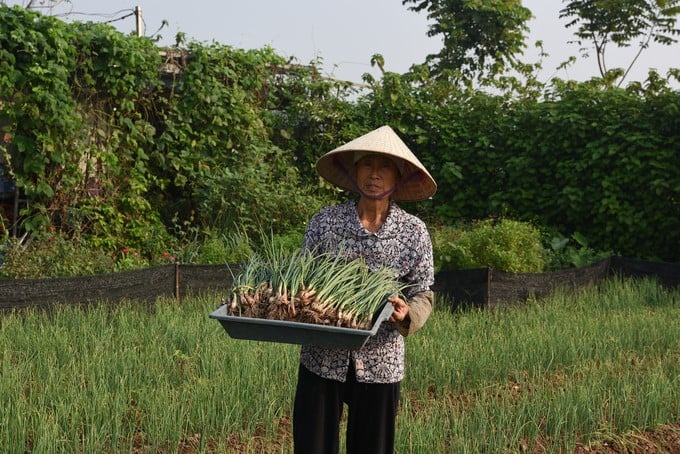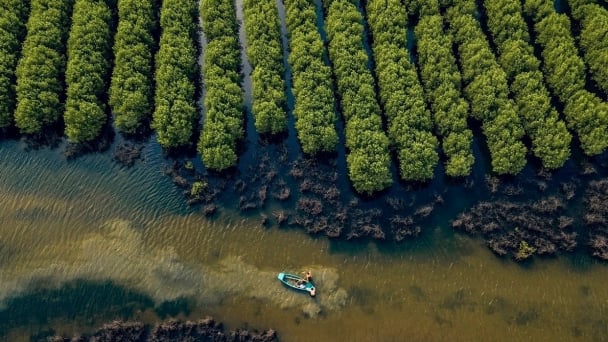June 15, 2025 | 12:07 GMT +7
June 15, 2025 | 12:07 GMT +7
Hotline: 0913.378.918
June 15, 2025 | 12:07 GMT +7
Hotline: 0913.378.918
Assoc. Prof. Dr. Vu Nang Dung, Chairman of the Vietnam Soil Science Association (VSSA), said that when talking about soil health, dissemination work is very important so that people understand what it is.
Since the 1960s, we have mainly made soil maps, which determined physical and chemical criteria, and added microorganisms in the soil, but very few. Healthy soil means safe agricultural products and healthy people. However, there are no criteria to evaluate soil health, or they are still one-sided.

Agricultural land in many places in Vietnam is degraded on many levels.
To know soil health, it is compulsory to build a database, proceed to manage crop nutrition, and thereby determine the origin of agricultural products, who makes them, and whether the production process is safe or not. We have not yet done these things and are now actively building them.
MARD's soil health program is a bit late, but it is good because there is a long-term strategy for researching soil health. According to recent statistics from the Ministry of Natural Resources and Environment, up to 33% of agricultural land is mildly degraded, moderately degraded, and severely degraded, but mainly mildly and moderately degraded.
The first content in the soil health program is to identify the consistent map of main soil groups and soil types nationwide. The second is to determine the criteria for each main soil type with each main crop, thereby establishing a scale of soil health.
With criteria, it is possible to know which areas of soil are good and which areas need to be improved in terms of physical, chemical, and microbial properties. Degraded soil contains little organic matter and nutrients that are beneficial to plants. When the biological system beneficial to plants weakens, harmful species naturally develop, causing fungal infections and diseases.

Assoc. Prof. Dr. Vu Nang Dung, Chairman of the Vietnam Soil Science Association. Photo: Duong Dinh Tuong.
One of Vietnam's most successful innovations is agriculture. Vietnam currently has about 11.8 million hectares of arable land and a population of 100 million people. Thus, only with 1,100 m² of arable land/person, Vietnam not only ensures food security and exports a lot. Agricultural exports this year can exceed USD 60 billion. This is a great achievement that the world admires because countries with low average arable land cannot do that.
However, along with the increased productivity and output, the soil is also stripped of many things, causing soil degradation. The deepest cause is too little organic matter fertilization. Previously, during the cooperative period, each hectare could be applied with up to 10–15 tons of organic fertilizer. But farmers now like chemical fertilizers because of their clear and fast effects. Besides, the conditions for producing organic fertilizers are currently difficult, and the cost and labor costs are high.
With less use of organic fertilizer, soil health will deteriorate in three factors. First is physical properties. The structure of the soil without organic matter is not sustainable and is easily destroyed. Second, in terms of chemical properties, the pH of the soil decreases, making the soil more acidic, so plants grow less, the soil's ability to hold nutrients is poor, and nutrients are easily washed away. Third, in terms of soil biology, when organic matter is low, the systems of bacteria and fungi that are beneficial to plants and the soil become weaker, and conversely, harmful types thrive, causing imbalance and more diseases for plants.

Harvesting onions at Gen Green organic farm (Phuc Tho district, Hanoi City). Photo: Duong Dinh Tuong.
For example, currently, replanted coffee trees are very green in the first few years, but then the leaves turn yellow and the roots are destroyed, mainly due to nematodes. There are now very clear criteria, such as how many nematodes per 100 grams of soil then coffee cannot be replanted. Soil health evaluation also requires such criteria.
VSSA can preside over the classification of land use nationwide, which is the basis for later evaluation of soil health. According to Mr. Dung, developing a set of evaluation criteria is also necessary, but it should be assigned to institutes, such as the Soils and Fertilizers Institute that is working with IRRI in six provinces to determine a set of criteria for rice soil.
"The criteria must be through actual surveys. These criteria will vary by region, soil type, and variety. When building a soil database and combining the digitization of cadastral maps, farmers can exploit the information to arrange production processes and reduce the amount of fertilizer to both reduce costs and increase efficiency. Currently, there needs to be investment and policies to understand clearly what Vietnam's soil is like to take care of it, as taking care of the food we eat every day and our own health," Mr. Dung emphasized.
Mr. Dung believes that if the soil health program becomes a national target program, it will be very good because this must be a long-term job, not just done for one or two years. Advanced countries have been doing this for hundreds of years before achieving the current soil health. If Vietnam has a consistent strategy from top to bottom and from policy to investment, it can absolutely do it.

Research on soil in Vietnam currently does not meet the needs.
“I think there is no other way to build industrial parks in the Red River Delta and Mekong Delta than to take agricultural land. But how to get, how to plan, and how to implement the planning must have a strategy. Currently, when the national land use planning and provincial land use planning have been approved, it is necessary to check and supervise the taking of agricultural land, especially rice land.
Regarding cemetery land, currently in the Red River Delta and Mekong Delta, there is a huge problem related to spirituality, so we cannot do it right away. However, if this continues, there is a risk of losing agricultural land, especially in the Red River Delta, which may lose a district of agricultural land in the next 20 years. To solve this problem, first is dissemination. Second, officials must be exemplary. Organic farming that only has 1-2 graves in the field will not be recognized immediately," Mr. Dung stated.
Translated by Thu Huyen
![Turning wind and rain into action: [4] Bringing climate bulletins to remote and isolated areas](https://t.ex-cdn.com/nongnghiepmoitruong.vn/608w/files/linhnhp/2025/06/14/1152-z6704423696987_15fd32ffc26d590d204d520c9dac6786-nongnghiep-151141.jpg)
(VAN) The Vietnam Agriculture and Nature Newspaper interviewed Mr. Vu Thai Truong, Acting Head of Climate Change and Environment at UNDP Vietnam, to gain deeper insight into how climate bulletins are delivered to farmers.

(VAN) In Tien Giang, a high-tech shrimp farm has developed a distinctive energy-saving farming model that has yielded promising results.
![Turning wind and rain into action: [3] 300.000 farmers benefit from agro-climatic bulletins](https://t.ex-cdn.com/nongnghiepmoitruong.vn/608w/files/news/2025/06/12/e5a48259d6a262fc3bb3-nongnghiep-125122.jpg)
(VAN) The agro-climatic bulletin has become a valuable tool for farmers in the Mekong Delta. After more than five years of implementation, the initiative is gradually being expanded nationwide.
![Turning wind and rain into action: [2] Providing forecasts to the people](https://t.ex-cdn.com/nongnghiepmoitruong.vn/608w/files/news/2025/06/12/e5a48259d6a262fc3bb3-nongnghiep-103927.jpg)
(VAN) In addition to improving the quality of hydrometeorological forecasts, putting forecast bulletins into practical use is crucial for production and disaster prevention.

(VAN) Blue carbon is receiving attention for its rapid absorption capacity and vast potential. It represents a promising nature-based solution to respond to climate change.
/2025/06/11/3507-1-161904_583.jpg)
(VAN) Seagrass beds and coral reefs serve as 'cradles' that nurture life in the ocean depths, creating rich aquatic resources in Vietnamese waters.
![Turning wind and rain into action: [1] Forecasting for farmers](https://t.ex-cdn.com/nongnghiepmoitruong.vn/608w/files/news/2025/06/11/e5a48259d6a262fc3bb3-nongnghiep-111919.jpg)
(VAN) Weather is no longer just a matter of fate. Forecasts have now become an essential companion for farmers in every crop season.